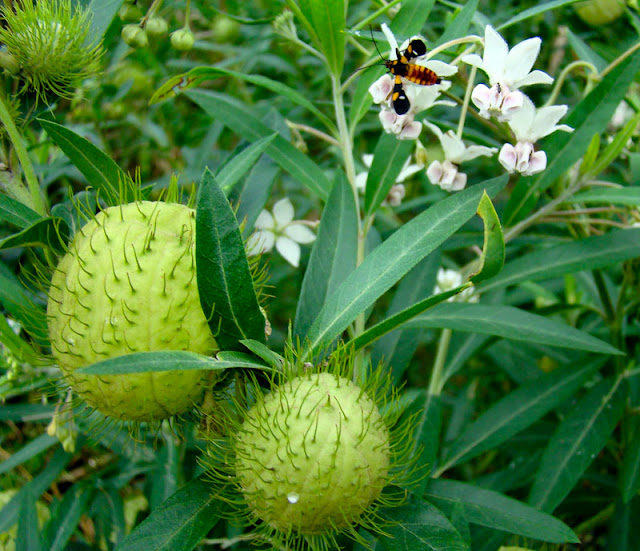African Monarch Butterfly Danaus chrysippus orientalis and Balloon Milkweed Gomphocarpus physocarpus
The African monarch Danaus chrysippus orientalis butterfly
which is widespread in Asia, Australia and Africa belongs to the Danainae
subfamily of the family Nymphalidae, is a medium-sized very attractive butterfly
with a wingspan of between 7–8 cm.
Larval food plants
In Durban the larval host plants of the African monarch
Danaus chrysippus are from the plant family Apocynaceae, in particular
Asclepiadoideae, Gomphocarpus physocarpus, and Stapelia gigantea being two of
them.
Gomphocarpus physocarpus Balloon
Milkweed
Gomphocarpus physocarpus which belongs to the vast milk plant family, Apocynaceae, is one of many host plants in its range of distribution but is probably the main host plant in the Durban area for the African Monarch butterfly, which both feeds on the nectar in the flowers and lays its eggs on the plant.
The caterpillars which are immune to the poisonous alkaloids in Gomphocarpus, have developed the ability to store them and pass them on to the pupa and adult butterfly, which use them to their own advantage making them foul-tasting and poisonous to predators.
The protection strategy of
Gomphocarpus has thus been effectively used by the African monarch for its own
protection.
Distribution and habitat of Gomphocarpus
physocarpus
Gomphocarpus physocarpus is widespread in South Africa,
occurring in the Western Cape, Eastern Cape, Kwa-Zulu Natal, Mpumalanga,
Gauteng, Limpopo, North West, as well as in Swaziland, Botswana, Zimbabwe and
Mozambique and northwards to Kenya. It is found growing in grassland and
bushveld, often along roadsides and in disturbed areas, from the coast to 900 m
above sea level. Although naturalized and widespread in South Africa for some
time, it is an introduced weed, native to tropical Africa.
The seeds are dispersed by wind, aided by the tuft of silky
hairs attached to each seed.
Uses
Gomphocarpus physocarpus is widely used in traditional
medicine in South Africa. The roots are used to treat stomachache. Leaves are
dried and ground into a powder that is taken as snuff for headaches. The milky
latex is used to treat warts. Seeds are blown away from the pods as a charm to
placate the ancestors. The stems are used for fiber. Fresh stems and leaves
stuffed into mole holes are said to be an effective deterrent. This plant is
poisonous if ingested and has caused death to sheep fed large amounts.
Gomphocarpus physocarpus is an attractive quick growing yet short lived plant for the indigenous garden that attracts masses of a large variety of insects to its showy flowers that produce plenty of nectar.
The showy
flowers are followed by large bladder like fruits that when mature split to
release hundreds of seeds that float on the air under shiny silk parachutes.
To have masses of these very attractive butterflies in your
garden all you have to do is buy a few plants from your local nursery, be given
some seedlings from a friend that has them or collect and plant your own seed
which germinates and grows without much attention.
Article written by Michael Hickman on the
30.04.24
Please visit my websites at
https://www.hlem.co.za/indigenous_plants/plants.html
other blogs at






_edited.jpg)




No comments:
Post a Comment